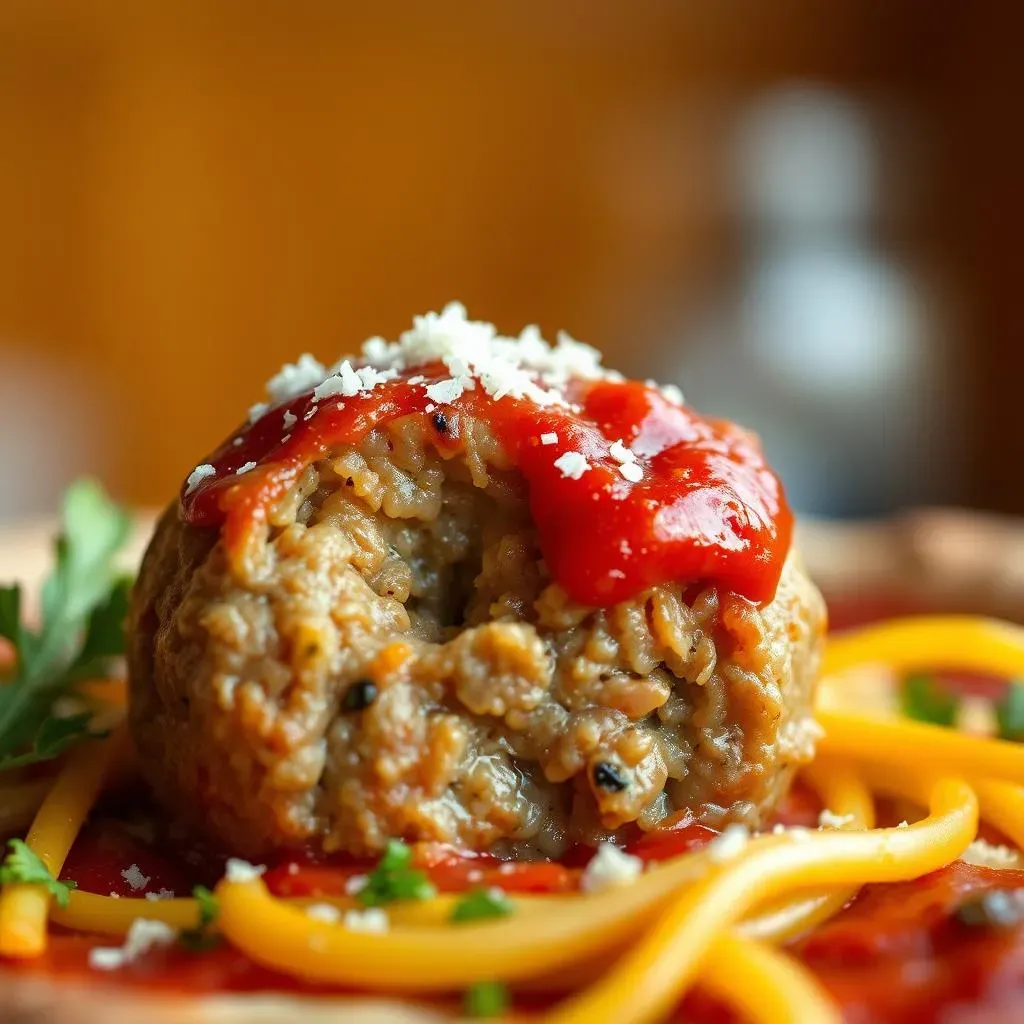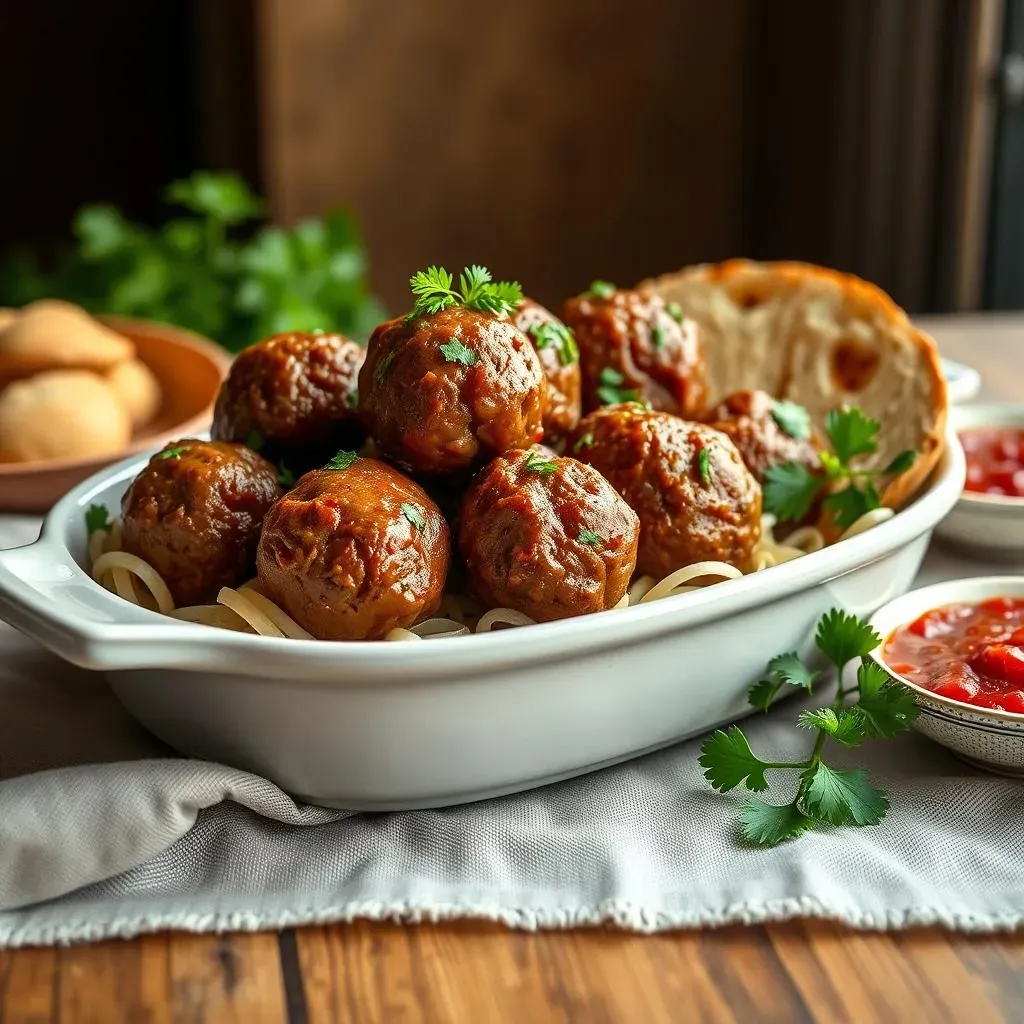Table of Contents
Ever dream of making meatballs so good they get five-star ratings? Forget those dry, flavorless hockey pucks; we're talking juicy, tender, melt-in-your-mouth perfection. This isn't just another recipe; it's a journey into the heart of what makes a truly great meatball. We’ll explore the essential ingredients, the techniques that elevate ordinary ground meat into something extraordinary, and the best ways to cook them – whether you prefer the stovetop or the oven. We'll also discuss how to serve and store your creations, ensuring they taste just as amazing the next day. So, ditch the takeout menus, grab your apron, and let's get started on mastering these 5 star meatball recipes. Get ready to become the meatball master you were always meant to be!
The Secret to 5Star Meatballs: Ingredients and Techniques

The Secret to 5Star Meatballs: Ingredients and Techniques
The Meat of the Matter
Alright, let's talk meat! Forget the mystery blends; for truly amazing meatballs, you need a solid foundation. I'm talking about a mix of ground beef and pork, usually equal parts. The beef brings that classic, rich flavor, while the pork adds moisture and a hint of sweetness. It's like a power couple for your taste buds! If you're feeling fancy, you can throw in some ground veal or even Italian sausage for extra oomph. Just remember, the better the quality of your meat, the better your meatballs will taste. Don't skimp on this part!
Now, some people will tell you that fresh meat is a must, and they're not wrong. Previously frozen meat can sometimes release more moisture, which can mess with the texture. If you are using frozen meat, make sure it’s thawed properly and pat it dry before mixing it with other ingredients.
Breadcrumbs: The Secret Weapon
Okay, here’s where the magic happens. Breadcrumbs aren't just filler; they're the secret to that tender, juicy texture we're all chasing. But not just any breadcrumbs will do. We're talking about *soft* breadcrumbs soaked in milk. This isn't some gourmet chef secret either, your grandma probably did this. The milk helps the breadcrumbs absorb moisture, which they then release into the meatballs as they cook. It's like a built-in hydration system. You can use fresh bread, crusts and all, or even dried breadcrumbs, but make sure you soak them well in milk before adding them. I personally find that fresh breadcrumbs work best, but dried ones work fine too!
Some people swear by using Italian seasoned breadcrumbs for an extra punch of flavor. If you are using these, remember to adjust the amount of extra salt and Italian seasonings you use in the recipe, so it doesn't become too salty.
Ingredient | Purpose |
|---|---|
Ground Beef | Rich Flavor |
Ground Pork | Moisture and Sweetness |
Milk-Soaked Breadcrumbs | Tender texture |
Flavor Boosters: Beyond the Basics
So, we've got our meat and our breadcrumbs; now, it's time to turn up the flavor. Don't be shy with your seasonings! We're talking about garlic, both fresh and powdered, onions, finely chopped, and plenty of Italian herbs like oregano, basil, and parsley. A touch of red pepper flakes will also give a nice kick. Don’t forget salt and freshly ground black pepper too! These aren't just random additions; they're a symphony of flavors that come together to create that iconic Italian meatball taste. And don't forget the cheese! Freshly grated Parmesan or Pecorino Romano is a must. It adds a salty, nutty depth that just can’t be beat. I also add a bit of egg to bind everything together, but don’t overdo it! You don’t want your meatballs to be rubbery.
Remember to mix everything gently with your hands. Overmixing can make the meatballs tough. You want them to be light and airy, not dense and compacted. It's a delicate balance, but you'll get the hang of it.
Cooking Your Meatballs: Stovetop vs. Oven

Cooking Your Meatballs: Stovetop vs. Oven
The Sizzle of the Stovetop
Okay, so you've got your perfectly mixed meatballs, and now it's time to cook them. You can go old-school and use the stovetop, which is how my grandma always did it. For this method, you'll want a large skillet with a bit of olive oil. Heat it up over medium heat, and then gently place the meatballs in, making sure not to overcrowd the pan. You'll want to brown them on all sides first. This creates a nice crust and locks in the juices. Once they're browned, you can add your sauce directly to the pan, bring it to a simmer, and let the meatballs cook through in the sauce. This method is great because the meatballs absorb all the yummy flavor from the sauce as they cook, but it does require a little more attention.
The key here is to be patient and not rush the process. You want the meatballs to be cooked through, but you also don't want them to be dry. The stovetop method allows you to control the heat and gives you a nice, even cook, but it can take a little longer and require some babysitting. If you're short on time, you might want to consider the oven method.
The Oven's Embrace
If you want a more hands-off approach, the oven is your friend. Preheat your oven to about 400°F (200°C). Place your meatballs on a baking sheet lined with parchment paper. This will prevent them from sticking and makes cleanup a breeze. You can also use a wire rack on top of the baking sheet to allow the heat to circulate more evenly around the meatballs. Then, bake them for about 20-25 minutes, or until they're cooked through. The oven provides a consistent heat that's great for cooking the meatballs evenly without needing to flip them constantly.
This method is great if you're cooking a large batch of meatballs or if you're busy with other things. It's less hands-on and frees you up to work on other parts of your meal. While the oven doesn't give you that direct contact with the pan for a crusty exterior, you can always finish them off in a pan for a few minutes after they're cooked.
Method | Pros | Cons |
|---|---|---|
Stovetop | Flavor absorption, Nice crust | Requires attention, Longer cook time |
Oven | Hands-off, Even cooking | Less crust, Might need a finish in pan |
Combining the Best of Both Worlds
Now, if you're feeling adventurous, you can combine both methods for the ultimate meatball experience. Start by browning the meatballs in a skillet on the stovetop to get that nice crust, then transfer them to a baking dish and finish cooking them in the oven. This gives you the best of both worlds: the flavor from the stovetop and the even cooking from the oven. You can add your sauce to the baking dish before putting them in the oven, or you can add it after they're cooked. It's really up to you.
No matter which method you choose, the key is to ensure that your meatballs are cooked through. Use a meat thermometer to check the internal temperature. It should reach 165°F (74°C) for safety. Remember, the goal is to make tender, juicy meatballs every time. It's all about practice and finding what works best for you. Don't be afraid to experiment and have fun with it!
Serving and Storing Your 5Star Meatballs

Serving and Storing Your 5Star Meatballs
Serving Suggestions: Beyond Spaghetti
Okay, so your meatballs are cooked to perfection. Now, how do you serve them? Sure, spaghetti and meatballs is a classic, and there's nothing wrong with that. But let's think outside the pasta box for a second. You can try them in a hearty meatball sub, loaded with melted cheese and peppers. Or how about serving them over creamy polenta or mashed potatoes? They also taste amazing as an appetizer, served with toothpicks and a side of marinara sauce for dipping. Don't be afraid to experiment and find your favorite way to enjoy your 5-star meatballs. There are no rules, just delicious possibilities!
I personally love to serve mine with some crusty bread for soaking up all that delicious sauce. A simple green salad on the side adds a nice fresh contrast to the richness of the meatballs. It's all about creating a balanced and satisfying meal. Remember, presentation matters too! A sprinkle of fresh herbs or a drizzle of olive oil can make your dish look as good as it tastes.
Freezing for Future Feasts
Here's a little secret: meatballs are the perfect make-ahead meal. They freeze beautifully, which means you can always have a batch on hand for those busy weeknights. To freeze, let your meatballs cool completely first. Then, arrange them in a single layer on a baking sheet lined with parchment paper and put it in the freezer for an hour or two. This prevents them from sticking together. Once they’re frozen solid, you can transfer them to a freezer-safe bag or container. Make sure to label the container with the date, so you know how long they’ve been in the freezer. They can stay in the freezer for up to 2 months and still taste great.
When you’re ready to eat them, you can either thaw them in the fridge overnight or cook them directly from frozen. If cooking from frozen, you’ll need to add a few extra minutes to the cooking time. I usually just throw them in a pot of simmering tomato sauce and let them heat through. It's a great way to have a quick and easy meal ready in minutes. It's like having your own personal stash of deliciousness!
"The best way to predict the future is to create it." - Peter Drucker. In this case, the future is a freezer full of meatballs.
Reheating and Keeping the Magic Alive
Reheating your meatballs is pretty simple. If they are already in sauce, you can just heat them up in a pot on the stovetop over medium heat, stirring occasionally, until heated through. If you’re reheating them without sauce, you can add a little bit of water or broth to the pan to prevent them from drying out. You can also reheat them in the oven at 350°F (175°C) for about 15-20 minutes, or until they’re heated through. Just make sure to cover them with foil to keep them moist.
The microwave is also an option for a quick reheat, but it might not give you the best texture. Sometimes, the meatballs can become a little rubbery. If you do use the microwave, reheat them in short intervals and cover them with a damp paper towel to help retain moisture. The key is to reheat them gently and not overcook them. You want to keep that tender, juicy texture that makes them so good. With these tips, you can enjoy your 5-star meatballs anytime you want, without sacrificing quality or flavor.